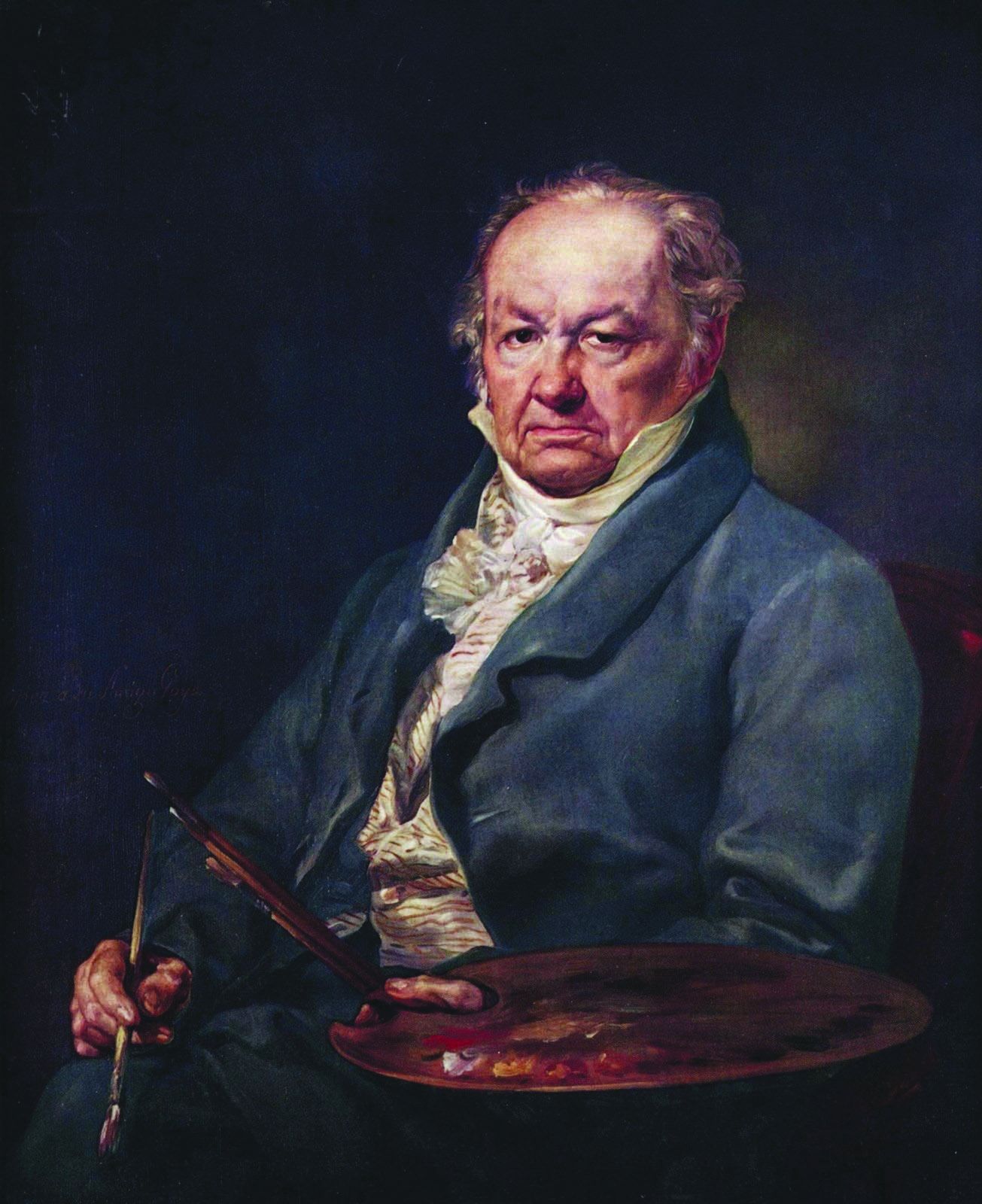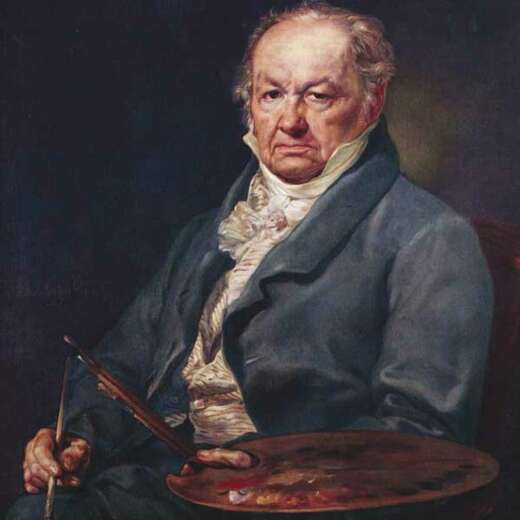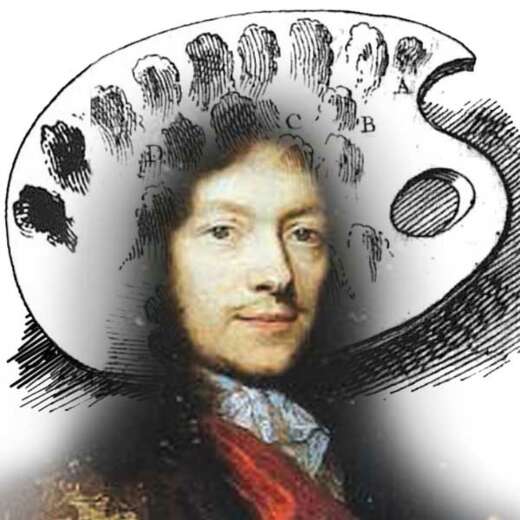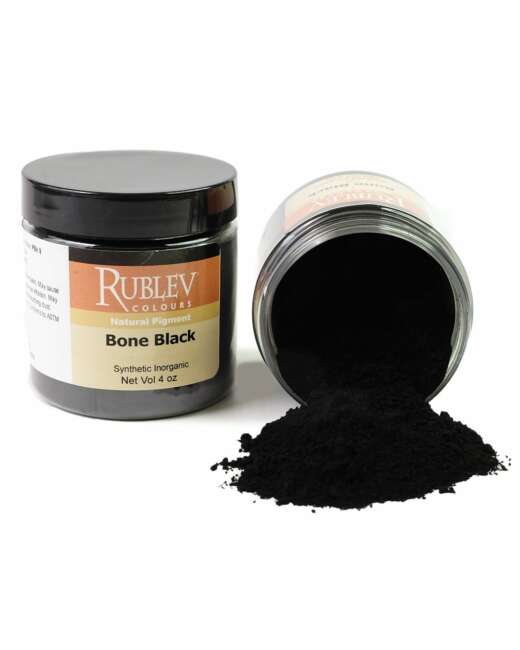
Besides an artist's notes or treatises on painting of the period, the systematic arrangement of separate colors and mixtures on the palette, which the painter prepared before he began his work, can be used to study the artist's painting procedures. Such palettes can be found in portraits or self-portraits, where the palette is held in hand with the rows of colors and tints visible.
One such portrait is the portrait of Francisco Goya with his palette, painted in 1827 by Vicente López y Potaña (1772–1850), shown at right.
Goya used nine distinct colors and arranged them on the palette, with white nearest the thumbhole and blacks on the opposite side.
Besides the white and blacks, there are only earth colors. We see the nine colors arranged along the outer edge of the palette as follows: Flake white, yellow ocher, brown ocher, light red, burnt Sienna, and four blacks. As on most 18th-century palettes, vermilion is placed separately near white, as is described in de Piles' palette.[1]
It seems that Goya used no scaled palette or row of tints at the center of the palette. We observe a flesh tint, the blacks, and a greenish and brownish tint that can be obtained by mixing the yellowish or reddish flesh tint with the black. An unusual feature of this palette is the great quantities of blacks (four) and the apparent absence of umbers. The abundant use of black for the groundwork of his paintings gives his pictures a definite character. There is no blue or green on Goya's palette.[2] Earth colors can be very brilliant and of high tinting strength: yellow ochre looks almost like Naples yellow, light red like vermilion, burnt Sienna like Crimson lake, and green earth (when used) like viridian.
Frédéric Schmid identifies the different blacks as bone black, lamp black, ivory black, and peach black. He admits this description of blacks, which in the painting have a warm or cold quality, is arbitrary and guesswork based on comparison with contemporary treatises where the blacks are described in words. For example, de Piles (1684) recommends two blacks in the row of the pigments, namely bone black and lamp black. Wyrsch (1732–1798), in his posthumously published treatise (1838), mentions three blacks, i.e., bone black, ivory black, and peach black.

This palette is based on F. Schmid, in which he identifies the following colors: 1. Lead white, 2. Yellow ocher, 3. Brown ocher, 4. Light red, 5. Burnt Sienna, 6–9. Blacks, a. Vermilion, b. Spot of black, c. Light yellowish flesh tint (yellow ocher and lead white), d. Greenish middle tint, e. Thin blacks, f. Burnt Siena and three brushes in hand.
Where to Buy
Purchase the genuine oil colors used by Goya:
Notes
1. The position of vermilion on palettes of the 17th century is described in the palette recommended by Roger de Piles in his painting treatise Les Premiers Elémens de Peinture Pratique, Paris, 1684. See Arthur Pope, The Language of Drawing and Painting, Cambridge, Mass., 1949, p. 130; W. G. Constable, The Painter's Workshop, London, 1954, pp. 122–123. De Pile's palette is reproduced in Frédéric Schmid, The Practice of Painting, London, 1948, figs. 26 & 27.
2. The palette described by de Piles does not contain blue, but it was a palette primarily set for flesh tones. Blue was used in exceptional circumstances, such as painting a dress, draperies, or sky in landscapes. In this case, a different palette was usually set up for those passages. Many French 18th-century artists (Nattier Vien, Duplessis, Drouais) did not place blue or green on their palettes. Also, on the palette of John Trumbull, who was trained in England and France, we find no blue and green (see Theodore Sizer, The Works of Colonel John Trumbull, New Haven, 1950, pp. 101–105).
References
W. G. Constable. The Painter's Workshop, London, 1954, pp. 122–123.
Roger de Piles. Les Premiers Elémens de Peinture Pratique, Paris, 1684. Jombert's edition 1767.
Arthur Pope. The Language of Drawing and Painting. Cambridge, Mass., 1949, p. 130.
Frédéric Schmid. The Practice of Painting. London, 1948, figs. 26 & 27.
Frédéric Schmid. "Some Observations on Artists' Palettes." The Art Bulletin, Vol. 40, No. 4 (Dec 1958), pp. 334–336.
Black is Black | How to Select the Right Black for Your Oil Painting
Many art instructors tell their students not to use black in their paintings. But is this good advice? is black a non-essential color on your palette? Tatiana Zaytseva, a cofounder of Natural Pigments, discusses the history of black pigments in oil painting and shows you how each different black makes neutral, warm, and cool gray tints. See how useful these blacks are in painting.














